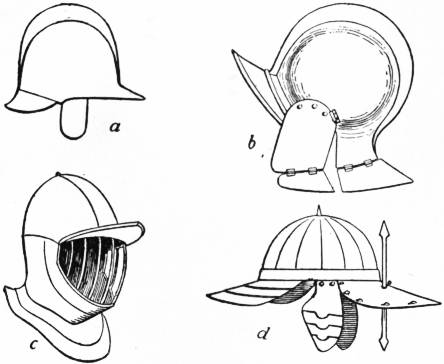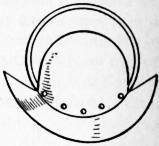Helmet
 From Britannica 11th Edition (1911)
From Britannica 11th Edition (1911) Helmet (from an obsolete diminutive of O. Fr. helme, mod. heaume; the English word is “helm,” as in O. Eng., Dutch and Ger.; all are from the Teutonic base hal-, pre-Teut. kal-, to cover; cf. Lat. celare, to hide, Eng. “hell,” &c.), a defensive covering for the head. The present article deals with the helmet during the middle ages down to the close of the period when body armour was worn. For the helmet worn by the Greeks and Romans see Arms and Armour.
The head-dress of the warriors of the dark ages and of the earlier feudal period was far from being the elaborate helmet which is associated in the imagination with the knight in armour and the tourney. It was a mere casque, a cap with or without additional safeguards for the ears, the nape of the neck and the nose (fig. 1). By those warriors who possessed the means to equip themselves fully, the casque was worn over a hood of mail, as shown in fig. 2. In manuscripts, &c., armoured men are sometimes portrayed fighting in their hoods, without casques, basinets or other form of helmet. The casque was, of course, normally of plate, but in some instances it was a strong leather cap covered with mail or imbricated plates. The most advanced form of this early helmet is the conical steel or iron cap with nasal (fig. 2), worn in conjunction with the hood of mail. This is the typical helmet of the 11th-century warrior, and is made familiar by the Bayeux Tapestry. From this point however (c. 1100) the evolution of war head-gear follows two different paths for many years. On the one hand the simple casque easily transformed itself into the basinet, originally a pointed iron skull-cap without nasal, ear-guards, &c. On the other hand the knight in armour, especially after the fashion of the tournament set in, found the mere cap with nasal insufficient, and the heaume (or “helmet”) gradually came into vogue. This was in principle a large heavy iron pot covering the head and neck. Often a light basinet was worn underneath it—or rather the knight usually wore his basinet and only put the heaume on over it at the last moment before engaging. The earlier (12th century) war heaumes are intended to be worn with the mail hood and have nasals (fig. 3). Towards the end of the 13th century, however, the basinet grew in size and strength, just as the casque had grown, and began to challenge comparison with the heavy and clumsy heaume. Thereupon the heaume became, by degrees, the special head-dress of the tournament, and grew heavier, larger and more elaborate, while the basinet, reinforced with camail and vizor, was worn in battle. Types of the later, purely tilting, heaume are shown in figs. 4 and 5.
 | |
| Fig. 4.—Heaume, 15th century. | Fig. 5.—Heaume, 15th century. |
 |
| Fig. 6.—Basinets. |
 |
 |
| Fig. 7.—Salades or Sallets. | |
The basinet, then, is the battle head-dress of nobles, knights and sergeants in the 14th century. Its development from the 10th-century cap to the towering helmet of 1350, with its long snouted vizor and ample drooping “camail,” is shown in fig. 6, a, b, c and d, the two latter showing the same helmet with vizor down and up. But the tendency set in during the earlier years of the 15th century to make all parts of the armour thicker. Chain “mail” gradually gave way to plate on the body and the limbs, remaining only in those parts, such as neck and elbows, where flexibility was essential, and even there it was in the end replaced by jointed steel bands or small plates. The final step was the discarding of the “camail” and the introduction of the “armet.” The latter will be described later. Soon after the beginning of the 15th century the high-crowned basinet gave place to the salade or sallet, a helmet with a low rounded crown and a long brim or neck-guard at the back. This was the typical headpiece of the last half of the Hundred Years’ War as the vizored basinet had been of the first. Like the basinet it was worn in a simple form by archers and pikemen and in a more elaborate form by the knights and men-at-arms. The larger and heavier salades were also often used instead of the heaume in tournaments. Here again, however, there is a great difference between those worn by light armed men, foot-soldiers and archers and those of the heavy cavalry. The former, while possessing as a rule the bowl shape and the lip or brim of the type, and always destitute of the conical point which is the distinguishing mark of the basinet, are cut away in front of the face (fig. 7 a). In some cases this was remedied in part by the addition of a small pivoted vizor, which, however, could not protect the throat. In the larger salades of the heavy cavalry the wide brim served to protect the whole head, a slit being made in that part of the brim which came in front of the eyes (in some examples the whole of the front part of the brim was made movable). But the chin and neck, directly opposed to the enemy’s blows, were scarcely protected at all, and with these helmets a large volant-piece or beaver (mentonnière)—usually a continuation of the body armour up to the chin or even beyond—was worn for this purpose, as shown in fig. 7 b. This arrangement combined, in a rough way, the advantages of freedom of movement for the head with adequate protection for the neck and lower part of the face. The armet, which came into use about 1475-1500 and completely superseded the salade, realized these requirements far better, and later at the zenith of the armourer’s art (about 1520) and throughout the period of the decline of armour it remained the standard pattern of helmet, whether for war or for tournament. It figures indeed in nearly all portraits of kings, nobles and soldiers up to the time of Frederick the Great, either with the suit of armour or half-armour worn by the subject of the portrait or in allegorical trophies, &c. The armet was a fairly close-fitting rounded shell of iron or steel, with a movable vizor in front and complete plating over chin, ears and neck, the latter replacing the mentonnière or beaver. The armet was connected to the rest of the suit by the gorget, which was usually of thin laminated steel plates. With a good armet and gorget there was no weak point for the enemy’s sword to attack, a roped lower edge of the armet generally fitting into a sort of flange round the top of the gorget. Thus, and in other and slightly different ways, was solved the problem which in the early days of plate armour had been attempted by the clumsy heaume and the flexible, if tough, camail of the vizored basinet, and still more clumsily in the succeeding period by the salade and its grotesque mentonnière. As far as existing examples show, the wide-brimmed salade itself first gave way to the more rounded armet, the mentonnière being carried up to the level of the eyes. Then the use (growing throughout the 15th century) of laminated armour for the joints of the harness probably suggested the gorget, and once this was applied to the lower edge of the armet by a satisfactory joint, it was an easy step to the elaborate pivoted vizor which completed the new head-dress. Types of armets are shown in fig. 8.
 |
| Fig. 8.—Armets. |
 |
| Fig. 9.—Burgonets. |
 |
| Fig. 10.—Morion. |
 |
| Fig. 11.—Cabasset. |
The burgonet, often confused with the armet, is the typical helmet of the late 16th and early 17th centuries. In its simple form it was worn by the foot and light cavalry—though the latter must not be held to include the pistol-armed chevaux-légers of the wars of religion, these being clad in half-armour and vizored burgonet—and consisted of a (generally rounded) cap with a projecting brim shielding the eyes, a neck-guard and earpieces. It had almost invariably a crest or comb, as shown in the illustrations (fig. 9). Other forms of infantry head-gear much in vogue during the 16th century are shown in figs. 10 and 11, which represent the morion and cabasset respectively. Both these were lighter and smaller than the burgonet; indeed much of their popularity was due to the ease with which they were worn or put on and off, for in the matter of protection they could not compare with the burgonet, which in one form or another was used by cavalry (and often by pikemen) up to the final disappearance of armour from the field of battle about 1670. Fig. 9 b gives the general outline of richly decorated 16th-century Italian burgonet which is preserved in Vienna. The archetype of the burgonet is perhaps the casque worn by the Swiss infantry (fig. 9 a) at the epoch of Marignan (1515). This was probably copied by them from their former Burgundian antagonists, whose connexion with this helmet is sufficiently indicated by its name. The lower part of the more elaborate burgonets worn by nobles and cavalrymen is often formed into a complete covering for the ears, cheek and chin, and connected closely with the gorget. They therefore resemble the armets and have often been confused with them, but the distinguishing feature of the burgonet is invariably the front peak. Various forms of vizor were fitted to such helmets; these as a rule were either fixed bars (fig. 9 c) or mere upward continuations of the chin piece. Often a nasal was the only face protection (fig. 9 d, a Hungarian type). The latest form of the burgonet used in active service is the familiar Cromwellian cavalry helmet with its straight brim, from which depends the slight vizor of three bars or stout wires joined together at the bottom.
The above are of course only the main types. Some writers class all remaining examples either as casques or as “war-hats,” the latter term conveniently covering all those helmets which resemble in any way the head-gear of civil life. For illustrations of many curiosities of this sort, including the famous iron hat of King Charles I. of England, and also for examples of Russian, Mongolian, Indian and Chinese helmets, the reader is referred to pp. 262-269 and 285-286 of Demmin’s Arms and Armour (English edition 1894). The helmets in brass, steel or cloth, worn by troops since the general introduction of uniforms and the disuse of armour, depend for their shape and material solely on considerations of comfort and good appearance. From time to time, however, the readoption of serviceable helmets is advocated by cavalrymen, and there is much to be said in favour of this. The burgonet, which was the final type of war helmet evolved by the old armourers, would certainly appear to be by far the best head-gear to adopt should these views prevail, and indeed it is still worn, in a modified yet perfectly recognizable form, by the German and other cuirassiers.
↧ Download as ZWI file | Last modified: 11/17/2022 15:23:33 | 15 views
☰ Source: https://oldpedia.org/article/britannica11/Helmet | License: Public domain in the USA. Project Gutenberg License
 ZWI signed:
ZWI signed: KSF
KSF